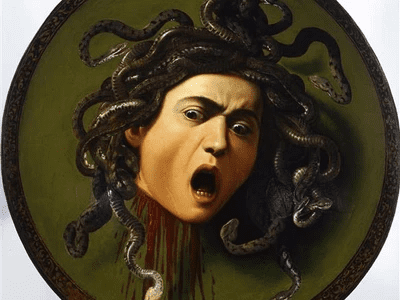All About Medusa by Caravaggio

Title of Artwork: “Medusa”

Artwork by Caravaggio
Year Created 1597
Summary of Medusa
One of Caravaggio’s most famous works is the Head of Medusa, which he painted twice. 1596 for the first, and 1597/8 for the second, both appear to have taken place. There is a first version of the painting known as Murtula (48×55 cm), which is signed Michel A F (Michel Angelo Fecit) and was discovered only after the painter’s death. It is now in private hands, while the second version, which is somewhat larger (60 x 55 cm) and unsigned, is housed in Florence’s Uffizi Gallery.
All About Medusa
Caravaggio’s “Head of Medusa” was commissioned by Cardinal Francesco Maria Del Monte, the Medici family’s agent in Rome, after he saw the earlier version – the Metula painting – on the painters’ studio floor.
Symbolizing the Grand Duke of Tuscany’s bravery in defeating his adversaries was the intent of this commission. With this painting, Caravaggio drew inspiration from the Greek story of Medusa, who was said to have turned humans to stone simply by gazing upon her.
Medusa was a female Gorgon monster from Greek mythology that terrified men and women alike. In Greek mythology, the term “Gorgon” refers to any of three sisters who had snake-like hair and a hideous face that turned all who saw them to stone.
Stheno and Euryale, the immortal sisters of the Gorgons, were murdered by the legendary hero Perseus, the fabled founder of Mycenae and the Perseid dynasty, although Medusa, the mortal sister, was not.
A mirrored shield was used by Perseus to avoid direct eye contact, according to the tale. The head of Medusa, severed from her neck, continued to terrify all who gazed upon it after her death.
Caravaggio plays with this idea by modelling himself for Medusa’s face – making him the only one who is safe from Medusa’s dedly gaze – and having to glance at his reflection to paint the shield in the same way that Medusa caught her own image seconds before she was slain.
In Caravaggio’s painting, Medusa is depicted with her head cut, yet she is not unconscious. Medusa’s fierce face heightens the tension between life and death. In her wide-open mouth, she lets out a silent but dramatic scream, her surprised eyes and brow furrowed in amazement, as if she thought she was impenetrable.
Because she does not look directly at us, Caravaggio’s Medusa does not have the full effect of frightening the observer, and so her doom is understated. Using a convex surface to appear concave and Medusa’s head to appear to extend outward, Caravaggio demonstrates a mastery of his craft in this work.
Information Citations
En.wikipedia.org, https://en.wikipedia.org/.
Recommend0 recommendationsPublished in Artworks







